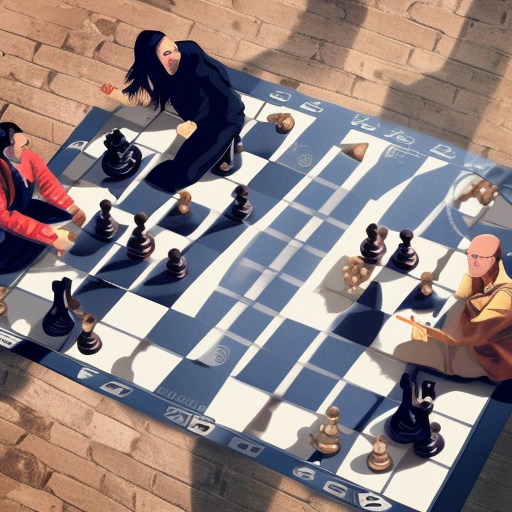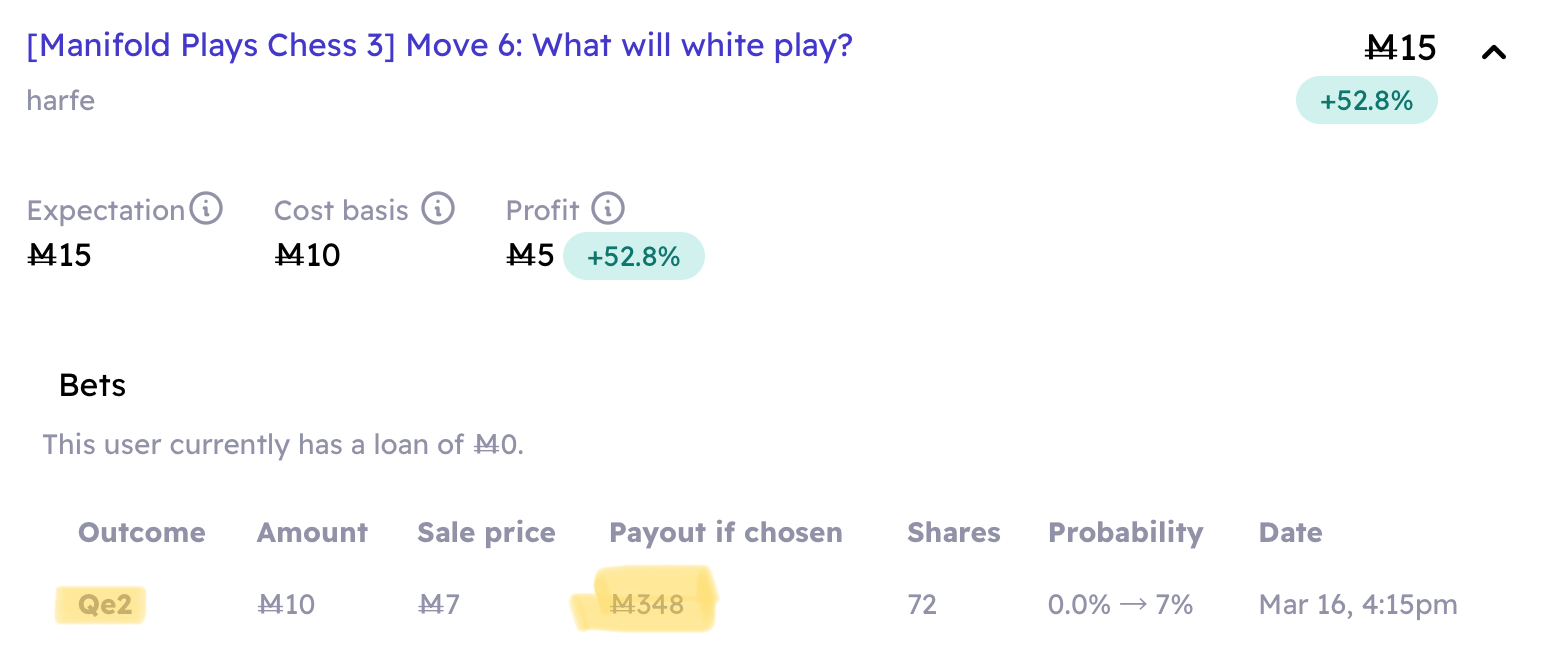
Check the game here: https://lichess.org/GF9YULQP.
The game so far: 1.e4 e5 2. Bc4 Nf6 3. Nc3 Nc6 4. Nf3 Nxe4 5. Nxe4 d5
The other candidate moves are 6. Bd3 and 6. Resign1.
The conditional markets for the other moves are here:
If the value (averaged over the last 4 hours before close) of this market is higher than in the other markets, then this market resolves PROB to the score after move 7. Otherwise, it resolves N/A. The score after move 7 is the value (averaged over the last 4 hours) of the conditional market of the winning move in move 6.
Note that when the game ends, the score will be 1.0 - #moves x 0.0004 if white wins, 0.5 - #moves x 0.0002 if its a draw, or 0.0 if we lose.
More details for the overall game here:
https://manifold.markets/harfe/will-white-win-in-manifold-plays-ch
@deagol can you explain what you were trying to do? i don't really know about market manipulation and shit, and i'd like to learn. i'm assume one doesn't ask a real trader that, but hopefully you can explain a bit if we just trade fake internet money?
@wadimiusz i was propping this up so to try force the other move higher (I benefit the higher the score given my 200 YES on the previous move). And I could use all my YeS on this crappy move to dump against others who might want it to win. I was aiming for ~0.7 score, while holding NO @67% on the other move (thinking ahead). Last minute dump is just in case not tying my capital here
@wadimiusz I’m pretty sure this won’t average higher than the other, so resolves N/A and all profit/loss returned, as if nothing ever happened here
@wadimiusz just notice these rules for Manifold Plays Chess game 3 are very particular to this structure @harfe came up with. Most other manifold markets have much simpler Y/N resolution, yet they can go also yoyo like crazy. Usually, if the resolution is related to a real world event, then you should be able to profit from some who hold crazy convictions.
@wadimiusz that might be a good idea for the next iteration of Manifold Plays Chess. I understand that @citrinitas has similar ideas.
@wadimiusz if you do that, once the move is made you end up with a long tail of identical markets. If you keep them open, tons of arbitrage loss. If they're closed, casual bettors end up with a ton of capital locked in over a 20+ move game, which people don't like and also more risk of creating perverse incentives
I messed around with local stockfish and it seems to think this is a much worse move 🤔 That after 6. Bd3, white and black are more or less equal, but after 6. Qe2, the position is evaluated at -65 centipawn (I analyzed with depth 25).
I don't completely understand, but we seem to lose a knight soon, unless the opponent screws up? (I understand that we expect SF3 to screw up, but one shouldn't rely on that, right?)
Also, the WDL stats seem to indicate that after this sequence of moves, black won many times, but white didn't win a single game:
>>> from stockfish import Stockfish
>>> stockfish = Stockfish("/usr/games/stockfish")
>>> stockfish.set_position("e2e4 e7e5 f1c4 g8f6 b1c3 b8c6 g1f3 f6e4 c3e4 d7d5 d1e2".split())
>>> stockfish.get_wdl_stats()
[858, 142, 0](These three numbers are wins, draws, and losses for black)
@wadimiusz I see Qe2 much worse, loses the bishop with a loss of tempo or 2 after 6 …dxc4 7.Qxc4 Be6 followed by f5, black keeps developing while we retreat, eventually castles queenside, tons of center pressure, they end with a much stronger position, nice pawn structure with the B pair, all worth more than a pawn maybe 2.
Yes currently black’s d pawn is forking our B and knight, so it’ll capture one of those. Remember we took black’s knight at e4, so Bd4 equalizes, just traded knights.
